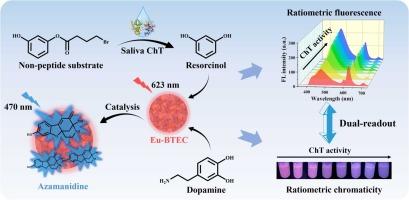Dual-Readout Analysis of Chymotrypsin Activity Based on Multifunctional Lanthanide Metal-Organic Framework
IF 3.7
1区 化学
Q1 CHEMISTRY, ANALYTICAL
引用次数: 0
Abstract
A ratiometric fluorescence/chromaticity dual-readout method is developed for chymotrypsin (ChT) activity detection, integrating a multifunctional lanthanide metal-organic framework (Ln-MOF) and an enzyme-activated fluorogenic reaction. A novel non-peptide substrate, 3-hydroxyphenyl-4-bromobutanoate (3-HPB), is rationally designed by coupling the catalytic specificity of ChT with a resorcinol-involved azamanidine fluorogenic reaction. Upon ChT-catalyzed hydrolysis, 3-HPB releases resorcinol, which subsequently reacts with dopamine to produce blue fluorescent azamanidine. In this reaction system, Eu-BTEC, a Ln-MOF constructed from Eu3+ and pyromellitic acid (H4BTEC), serves not only as a red fluorescent internal standard, but also facilitates confined catalysis and enhances the fluorogenic reaction. A ratiometric fluorescence method is thus established to detect ChT activity in human saliva. Furthermore, a portable visual device composed of a UV lamp and an illuminance meter enables ratiometric chromaticity (B/R) analysis. Both methods have low detection limits (0.0107 U mL-1 and 0.0144 U mL-1) and high accuracy (82.4-107.0% recovery). The ChT activities in real human saliva samples obtained by both methods are in good agreement (p > 0.05). This work not only presents a new strategy for ChT activity detection but also introduces a structure-simple, affinity-high substrate, offering a promising platform for future development of sensitive and reliable enzymatic assays.

基于多功能镧系金属-有机骨架的凝乳胰蛋白酶活性双读数分析
结合多功能镧系金属-有机骨架(Ln-MOF)和酶激活荧光反应,建立了一种用于胰糜蛋白酶(ChT)活性检测的比例荧光/色度双读出方法。将ChT的催化特异性与间苯二酚参与的azamanidine荧光反应偶联,合理设计了一种新的非肽底物- 3-羟基苯基-4-溴丁酸酯(3-HPB)。经cht催化水解,3-HPB释放间苯二酚,随后与多巴胺反应生成蓝色荧光azamanidine。在该反应体系中,由Eu3+和邻苯二甲酸(H4BTEC)构建的mn - mof Eu-BTEC不仅可以作为红色荧光内标,还可以促进限制性催化,增强荧光反应。建立了比值荧光法检测人唾液中ChT活性的方法。此外,由紫外灯和照度计组成的便携式视觉装置可实现比率色度(B/R)分析。两种方法检出限低(0.0107 U mL-1和0.0144 U mL-1),准确度高(回收率为82.4 ~ 107.0%)。两种方法获得的真实人唾液样品中的ChT活性具有很好的一致性(p > 0.05)。这项工作不仅提出了一种新的ChT活性检测策略,而且还引入了一种结构简单,亲和力高的底物,为未来开发灵敏可靠的酶分析提供了一个有希望的平台。
本文章由计算机程序翻译,如有差异,请以英文原文为准。
求助全文
约1分钟内获得全文
求助全文
来源期刊

Sensors and Actuators B: Chemical
工程技术-电化学
CiteScore
14.60
自引率
11.90%
发文量
1776
审稿时长
3.2 months
期刊介绍:
Sensors & Actuators, B: Chemical is an international journal focused on the research and development of chemical transducers. It covers chemical sensors and biosensors, chemical actuators, and analytical microsystems. The journal is interdisciplinary, aiming to publish original works showcasing substantial advancements beyond the current state of the art in these fields, with practical applicability to solving meaningful analytical problems. Review articles are accepted by invitation from an Editor of the journal.
 求助内容:
求助内容: 应助结果提醒方式:
应助结果提醒方式:


